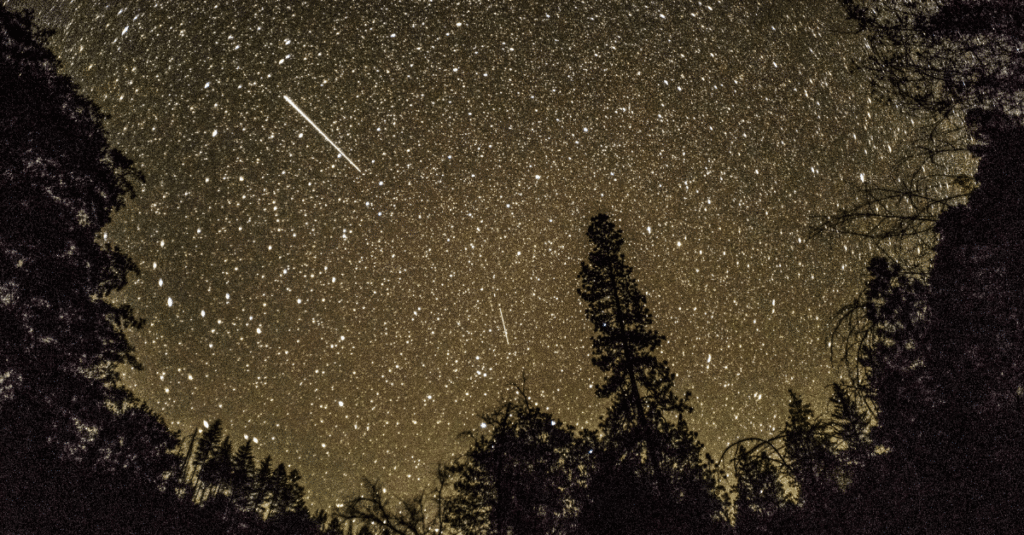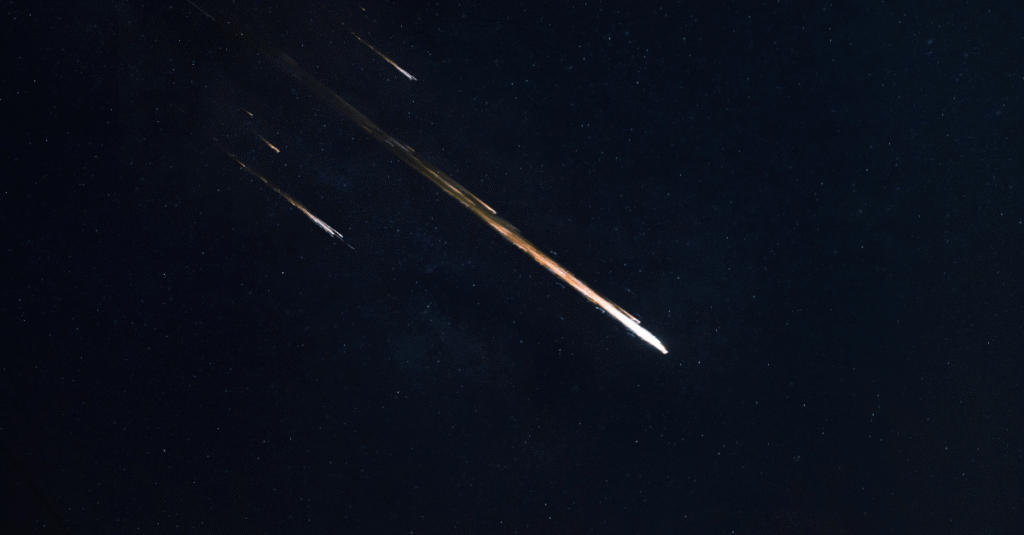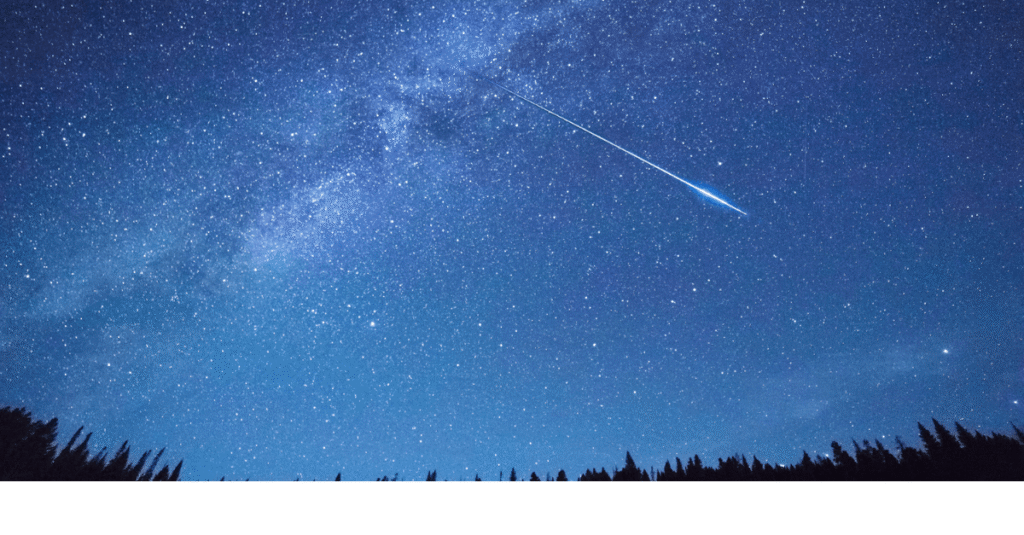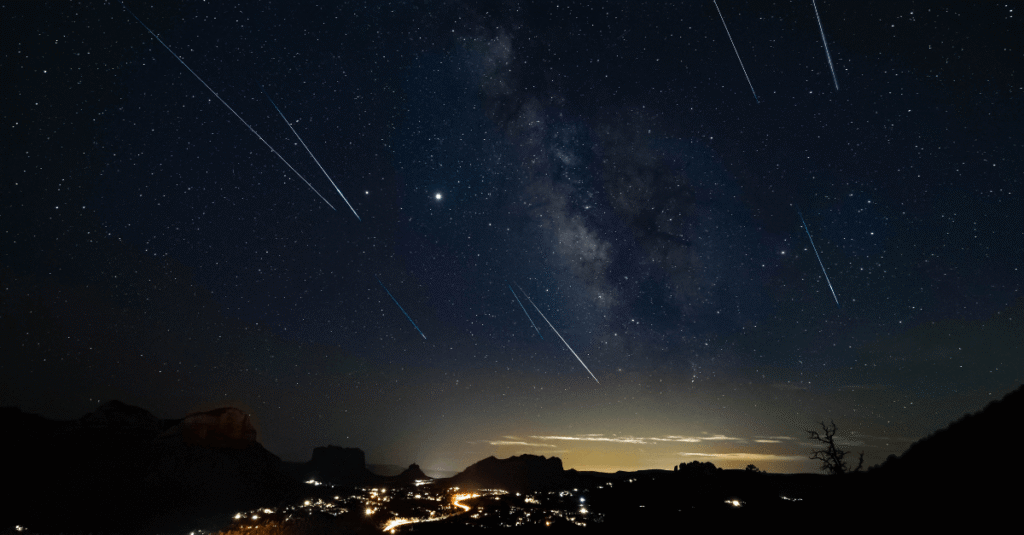In the vast canvas of our solar system, a meteor shower is a fascinating display of cosmic wonders. A sudden flash of light in the night sky. Known to us as a meteor shower, it results from dust and rock fragments floating in space entering the Earth’s atmosphere. This extraordinary phenomenon is a matter of immense curiosity for astronomers and the common man. In this article, we will discuss the origins of meteor showers, the science behind them, the best ways to observe them, and their impact on human history.
Meteor Shower

A meteor shower is a cosmic event in which numerous meteors enter the Earth’s atmosphere and burn up. This creates a fascinating stream of light in the night sky. These meteors are dust particles or debris left behind by comets or asteroids. When the Earth passes through this dust cloud in its orbit, these particles enter the atmosphere at high speed and burn up due to friction. This burning is what we see as a meteor shower.
Difference between meteor, meteorite and meteor shower
We usually confuse these three words, but there is a subtle difference between them:
- Meteor: When a dust particle or small piece of rock floating in space enters the Earth’s atmosphere and burns up, it is called a meteor or ‘shooting star’.
- Meteoroid: Rocks or dust particles that are floating in space are called meteorites. They can be parts of comets or asteroids.
- Meteorite: If a meteorite does not burn completely in the atmosphere and hits the Earth’s surface, that solid object is called a meteorite.
So, a meteorite in space is a meteorite in the atmosphere. If it falls on Earth, it is a meteorite.
The Science Behind Meteor Showers: Why and How Do They Happen?
Comets are the main source of meteor showers. Comets are a type of celestial body made of ice, dust, and rock. When a comet comes close to the Sun, the ice melts from its body, creating a long tail of gas and dust. These dust particles spread out along the comet’s orbit.
When the Earth approaches the orbit left by this comet in its annual path, the dust particles enter the Earth’s atmosphere due to gravity. These particles hit the atmosphere at about 11 to 72 kilometres per second. This tremendous speed and friction with the atmospheric air generate much heat, which burns these particles. This glowing line of light is a meteor.
When many meteors enter the Earth’s atmosphere simultaneously, it is called a meteor shower. Since the Earth passes through the orbit of a particular comet at a specific time each year, meteor showers are also visible at specific times of the year.
Radiant Point
When viewing a meteor shower, it appears as if the meteors are radiating from a specific point in the sky. This point is called the radiant point. The meteor shower is named after the constellation in which this radiant point is located. For example, the radiant point of the Perseid meteor shower is located in the constellation Perseus. Similarly, the Leonid meteor shower is centred in the constellation Leo, and the Geminid meteor shower is centred in the Gemini.
How and when can you watch the Perseids?

According to Finn Burridge, science communicator at the Royal Observatory Greenwich, the peak times for the Perseids in 2025 are the nights of 11-12 and 12-13 August.
He stated that although there would be a little more activity on August 12, the weather should be comparable on both nights.
Although some may be visible earlier in the night, meteors usually increase after midnight, and the best viewing occurs right before daybreak.
The bright Sturgeon Moon, which reached its full phase on August 9 and will remain highly luminous, coincides with this year’s peak.
“This year’s peak unfortunately lines up with a full Moon meaning even in dark sky areas it will be impossible to see the full 100 meteors per hour,” stated Burridge.
“However, [the Sturgeon Moon] is no reason not to go out and enjoy the shower – it is still likely that you will see at least 1 or 2 fireballs per hour, even with a full moon,” he stated.
Though there will be less meteor activity, if you want a darker sky, try watching on nights between August 16 and 26.
“Dates nearer to the shower’s peak offer the best chance, but this also coincides with the full Moon,” added Burridge.
“After the full Moon is more likely the better time to view, since the Moon will rise later in the night, so I would recommend the peak nights as well as weekend of 16 and 17 August,” he stated.
- Some pointers to “maximise your chances of seeing a shooting star” were provided by Mr. Burridge.
- As much of the sky as possible should be seen, free from obstructions like hills, trees, or buildings.
- Look up while lying on your back since meteors might appear anywhere in the sky.
- View from a location away from the glaring lights of cities or towns, but make sure you have a charged phone, some water, and that you have informed someone of your destination.
- Have patience. You’re more likely to spot one if you spend more time outside. Your eyes must be exposed to darkness for at least twenty minutes to adjust.
Some of the world’s most famous meteor showers

Every year, several spectacular meteor showers fascinate people around the world.
Perseids: Summer Night’s Best Attraction
The Perseid meteor shower, seen in mid-August, is one of the most popular celestial events in the Northern Hemisphere. Its source is Comet Swift-Tuttle. These meteors are very bright and long-lasting, which gives viewers an extraordinary experience.
Geminids: The King of the Winter Night
The Geminid meteor shower dominates the sky in December. It is one of the most reliable and dense meteor showers. Its speciality is that its source is not a comet, but an asteroid called 3200 Phaethon. Its meteors are slow-moving and bright yellow, which makes it unique.
Leonids: Historical meteor storm
The Leonid meteor shower is famous for creating a huge meteor storm once every 33 years. During the Leonid storm of 1833, thousands of meteors were simultaneously seen every hour, frightening and fascinating people. Its source is Comet Tempel-Tuttle.
How to Enjoy a Meteor Shower: A Complete Guide
You don’t need an expensive telescope or equipment to watch a meteor shower. It’s best viewed with the naked eye. Here are some tips to make your meteor shower viewing experience even better:
- Choose the right time and place: First, determine when the meteor shower is most active. Meteor showers are usually best seen from after midnight to before dawn. Choose a dark spot away from the city with low light pollution. A village, a remote area, or a park can be ideal.
- Check the weather forecast: Clear skies are essential. Plan for a cloudless night by checking the weather forecast.
- Allow your eyes to adjust: After reaching a dark place, give your eyes at least 20-30 minutes to adjust to the darkness. Avoid looking at your mobile phone screen during this time, as it can impair your night vision. Use a red light torch if necessary.
- Take comfort: Watching a meteor shower requires patience. Lie under the open sky with a comfortable chair, blanket or sleeping bag. This will give you a full view of the sky and will not cause neck pain.
- Be patient: Meteors appear sporadically and intermittently. So don’t get discouraged and wait. Your patience and calm environment will help you enjoy this amazing nature show.
- Don’t look at the centre of the glow: Although meteors spread out from a specific centre of glow, the brightest and longest-lasting meteors are usually seen some distance from the centre of the glow. So keep your eyes on the entire sky.
The impact of meteor showers on human culture and history

Since ancient times, meteor showers in the night sky have aroused people’s wonder, curiosity, and fear. They have been interpreted in different ways in different cultures.
- Mythology and folklore: In many ancient cultures, meteor showers were seen as signs of the gods or the arrival or departure of souls to Earth. The Greeks believed that they were a sign of the gods looking down on humans. In some cultures, meteor showers are considered a symbol of good luck, and it is believed that any wish made during this time will be fulfilled.
- Symbol of fear and misfortune: On the other hand, in some cultures, meteor showers were seen as bad omens or harbingers of impending disaster. During the Leonid storm of 1833, ordinary people in America thought the end of the world had arrived.
- Advances in Science: Over time, the clouds of superstition have lifted. Science has taught us that meteor showers are not a miracle, but a natural and predictable cosmic phenomenon. Astronomers can now accurately predict their source, trajectory, and timing.
Today, meteor showers bring people together around the world. Families and friends gather under the open sky to enjoy this cosmic beauty, which reminds us of the vastness of nature and relieves us from the hustle and bustle of daily life.
Frequently Asked Questions (FAQs)
Here are answers to some common questions about meteor showers:
1. Are meteor showers dangerous? Can meteors hit Earth?
In general, meteor showers are not dangerous at all. Meteors are dust or sand-like in size and burn up as soon as they enter the atmosphere. Large meteors hitting Earth (meteor showers) are very rare. Our atmosphere acts as a natural shield.
2. When is the best time to see a meteor shower?
Each meteor shower has a peak period, usually lasting one or two nights. This is when the most meteors are visible. The sky is darkest after midnight and just before dawn, so this is the ideal time to see meteors.
3. Are meteor showers noisy?
Meteors usually burn high in the atmosphere (about 70-100 km), so no sound reaches Earth. However, in some cases, strange sounds have been reported from very bright meteors (bolides or fireballs), although the scientific explanation for this is still unclear.
4. Is it possible to see meteors every day?
Yes, seeing a few meteors sporadically on any clear night is possible. It is very common to see a few meteors per hour. However, this number increases many times during a meteor shower.
5. How to take pictures of a meteor shower?
To photograph a meteor shower, you need a DSLR or mirrorless camera, a wide-angle lens, and a sturdy tripod. The camera must be set to manual mode and use a long exposure (usually 15-30 seconds). The best results are obtained by taking pictures with a high ISO (like 1600 or 3200) and a lens aperture as wide open as possible (like f/2.8).
Conclusion
Meteor showers are a wonderful gift from nature. They remind us of how small we are in this universe and how mysterious and beautiful the sky above us is. It is a wonderful combination of science and beauty. So the next time you hear about a meteor shower, don’t miss the opportunity to go further from the city and stand under the open sky to enjoy this cosmic fireworks display. This experience will give you a rare chance to be one with nature and appreciate the vastness of the universe.

Hi, I’m M Saif, a digital marketer with a strong focus on SEO and content writing. I help businesses improve their online visibility, drive organic traffic, and create engaging content that converts. With a results-driven approach, I work on strategies that not only boost rankings but also deliver real value to audiences.












Leave a Reply